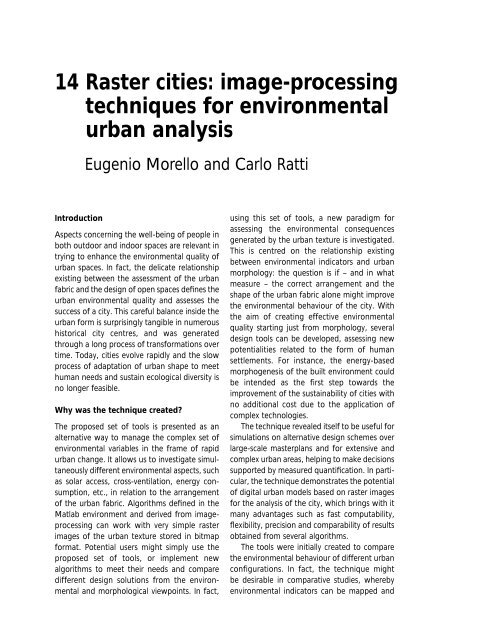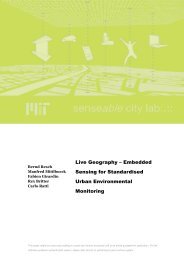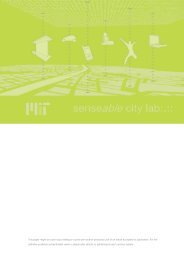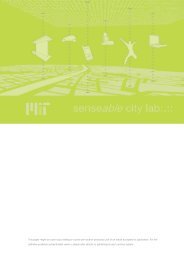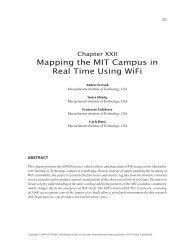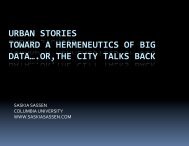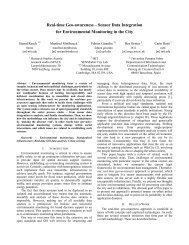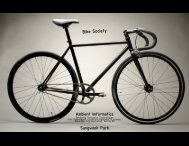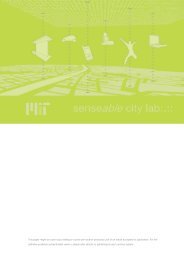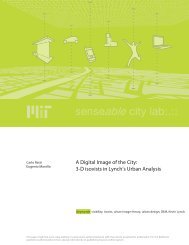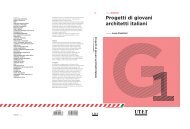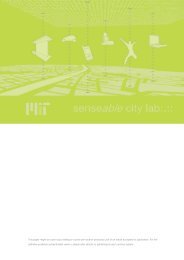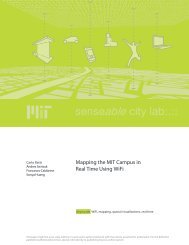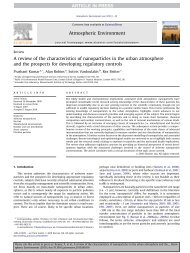Raster cities - MIT SENSEable City Lab
Raster cities - MIT SENSEable City Lab
Raster cities - MIT SENSEable City Lab
You also want an ePaper? Increase the reach of your titles
YUMPU automatically turns print PDFs into web optimized ePapers that Google loves.
4993P URBAN SUST 09-20-A/rev/lb.qxd 1/10/07 16:26 Page 119<br />
1EEE<br />
2<br />
3<br />
4EEE<br />
5<br />
6<br />
7<br />
8<br />
9<br />
10<br />
1<br />
2<br />
3<br />
4<br />
5<br />
6EEE<br />
7<br />
8EEE<br />
9<br />
20<br />
1<br />
2<br />
3<br />
4<br />
5EEE<br />
6<br />
7<br />
8<br />
9<br />
30<br />
1<br />
2<br />
3<br />
4<br />
5<br />
6<br />
7<br />
8<br />
9<br />
40<br />
1<br />
2<br />
3<br />
4<br />
5<br />
6<br />
7<br />
8<br />
9<br />
50EEE<br />
14 <strong>Raster</strong> <strong>cities</strong>: image-processing<br />
techniques for environmental<br />
urban analysis<br />
Introduction<br />
Eugenio Morello and Carlo Ratti<br />
Aspects concerning the well-being of people in<br />
both outdoor and indoor spaces are relevant in<br />
trying to enhance the environmental quality of<br />
urban spaces. In fact, the delicate relationship<br />
existing between the assessment of the urban<br />
fabric and the design of open spaces defines the<br />
urban environmental quality and assesses the<br />
success of a city. This careful balance inside the<br />
urban form is surprisingly tangible in numerous<br />
historical city centres, and was generated<br />
through a long process of transformations over<br />
time. Today, <strong>cities</strong> evolve rapidly and the slow<br />
process of adaptation of urban shape to meet<br />
human needs and sustain ecological diversity is<br />
no longer feasible.<br />
Why was the technique created?<br />
The proposed set of tools is presented as an<br />
alternative way to manage the complex set of<br />
environmental variables in the frame of rapid<br />
urban change. It allows us to investigate simultaneously<br />
different environmental aspects, such<br />
as solar access, cross-ventilation, energy consumption,<br />
etc., in relation to the arrangement<br />
of the urban fabric. Algorithms defined in the<br />
Matlab environment and derived from imageprocessing<br />
can work with very simple raster<br />
images of the urban texture stored in bitmap<br />
format. Potential users might simply use the<br />
proposed set of tools, or implement new<br />
algorithms to meet their needs and compare<br />
different design solutions from the environmental<br />
and morphological viewpoints. In fact,<br />
using this set of tools, a new paradigm for<br />
assessing the environmental consequences<br />
generated by the urban texture is investigated.<br />
This is centred on the relationship existing<br />
between environmental indicators and urban<br />
morphology: the question is if – and in what<br />
measure – the correct arrangement and the<br />
shape of the urban fabric alone might improve<br />
the environmental behaviour of the city. With<br />
the aim of creating effective environmental<br />
quality starting just from morphology, several<br />
design tools can be developed, assessing new<br />
potentialities related to the form of human<br />
settlements. For instance, the energy-based<br />
morphogenesis of the built environment could<br />
be intended as the first step towards the<br />
improvement of the sustainability of <strong>cities</strong> with<br />
no additional cost due to the application of<br />
complex technologies.<br />
The technique revealed itself to be useful for<br />
simulations on alternative design schemes over<br />
large-scale masterplans and for extensive and<br />
complex urban areas, helping to make decisions<br />
supported by measured quantification. In particular,<br />
the technique demonstrates the potential<br />
of digital urban models based on raster images<br />
for the analysis of the city, which brings with it<br />
many advantages such as fast computability,<br />
flexibility, precision and comparability of results<br />
obtained from several algorithms.<br />
The tools were initially created to compare<br />
the environmental behaviour of different urban<br />
configurations. In fact, the technique might<br />
be desirable in comparative studies, whereby<br />
environmental indicators can be mapped and


